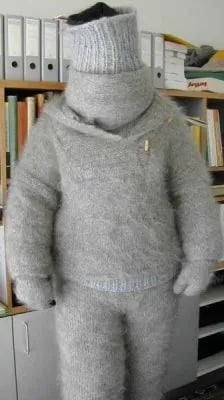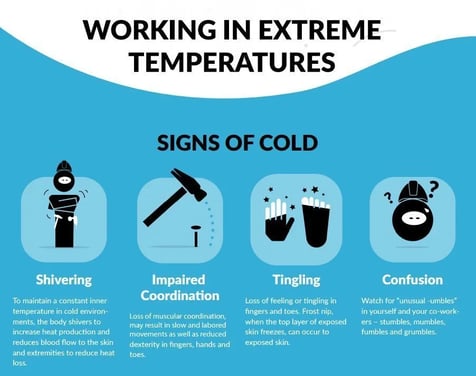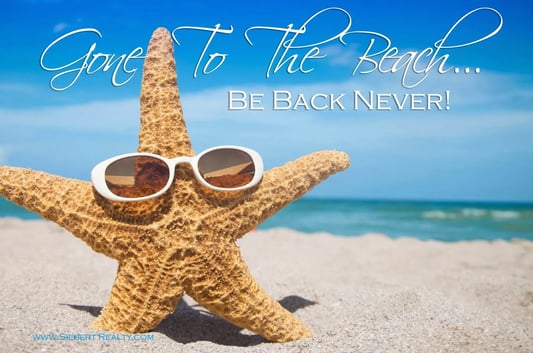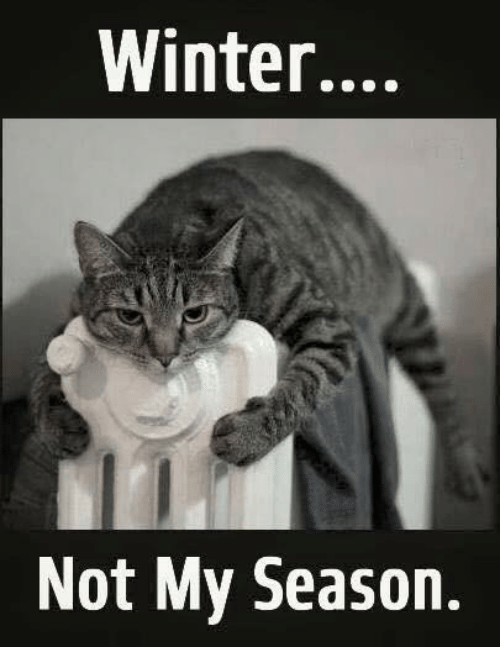Baby It’s Cold Outside
We moan when it’s too hot and we moan when it’s to cold. Part of being British right?! We love a good weather discussion. Whether it be extreme heat or bitter cold, there are health and safety implications to consider. When the weather is colder, we have to use more energy to stay warm and this is further amplified when it is windy, raining or snowing; your body loses heat even faster now. At an air temperature of 10°C, if the wind speed is 20mph, the effective temperature is 0°C. There is no specific temperature stated by law when it comes to construction work however much of the law refers to temperatures as ‘comfortable’ which tends to be 16°C or 13°C if much of your work is physical.
What The Law Says

We all have that person at work that feels the cold, whacks up the thermostat, wears 25 layers and still complains that ‘legally it’s too cold to be working!’ Sadly, for that person, the Health & Safety at Work Act (1974) doesn’t actually state a specific temperature requirement, however there is an inherent obligation to ensure the health, safety and welfare of all employees. The Management of Health and Safety at Work Regulations state that temperature must be considered as does the CDM (Construction, Design & Management). CDM mentions ‘the temperature at any place of work indoors is reasonable having regard for to the purpose for which that place is used.’ In terms of outdoor work, CDM express:
Every place of work outdoors shall, where necessary to ensure the health and safety of persons at work there, be so arranged that, so far as is reasonably practicable and having regard to the purpose for which that place is used and any protective clothing or work equipment provided for the use of any person at work there, it provides protection from adverse weather.
We must note here that Workplace Regulations do not apply to construction sites however they do apply to off-site manufacturing premises.
‘You’ll Catch Your Death’

We’ve all had a parent/grandparent urge us to pop on another layer else we’ll ‘catch our death!’ They would be utterly appalled at the local nightclubs Christmas party; temperatures dipping to almost freezing yet skimpy dresses right left and centre and never a coat in site! Well, Grandma does have a point, cold temperatures cause many health issues and can even be fatal. Cold temperatures can cause blood thickening, an increase in blood pressure and tightening of airways. The risk increases if you take certain medications, are in poor physical condition or suffer from illnesses such as diabetes, hypertension or cardiovascular disease. If your body temperature drops below 35°C you can be at risk of hypothermia; signs to look for include:
- Shivering and stomping your feet to keep warm
- Feeling unusually tired
- Loosing coordination
- Becoming confused
- Losing consciousness
You can also be at risk of Frostbite which is when your skin freezes. Look out for signs such as:
- Red/grey colouring/white patches
- Numbness so you can no longer feel the area
- In extreme cases, blistering
Trench foot can also be caused by the cold. If your foot is tingly/itchy, red and blotchy, swollen or numb, this can be time to be concerned. Chilblains are caused by repeated exposure of skin to temperatures from just above freezing to as high as 15°C. The cold damages the small blood vessels in the skin and damage is permanent. Chilblains tend to be found on the cheeks, ears, fingers and toes.
Other issues caused by cold weather include;
- Effects in behaviour-the cold can cause loss of concentration and errors in judgement that can lead to serious accidents. When you are cold blood is drawn away from the major organs towards to skin to keep you warm hence why you could feel like you’re not quite firing on all cylinders. Dangerous accidents can also happen when people make shortcuts to avoid the cold.
- Your manual dexterity can also be affected which can be critical if you are working machinery.
- Other musculoskeletal disorders can be triggered by the cold, particularly in the neck, shoulders, wrists and lower back.
- Finally, ice is a big hazard when working outdoors causing slipping hazards as well as problems with machinery.
Should We Just All Migrate?

The birds do it. The cold weather hits and they all fly south so maybe that’s the answer, we all head off to a Caribbean beach to escape the winter. And that’s where the daydream ends! So, what can we realistically do to deal with the cold?
Clothing: You’ve heard of the phrase ‘there’s no such thing as bad weather only inappropriate clothing’, well there’s truth in it. Shorts and a t-shirt wouldn’t really fit the bill come winter time instead wear several layers of loose clothing to provide better insulation (avoid tight clothing as it reduces blood circulation. Hats or hoods that cover your ears work wonders as do waterproof and insulated boots and gloves. Always carry spare clothes in case the ones you are wearing get wet.
Consider your building: Monitor access points if you work indoors, making sure doors and windows remain closed. Ensure you have adequate facilities for warming up and take frequent breaks in these warm areas especially if you are working outside. Ensure additional heating is provided if needed and possible. Finally consider re-phasing work or rotating amongst people is practical to ensure outdoor work.
Food and drink: Avoid becoming dehydrated by drinking warm, sweet liquids; sports drinks and soups can be great. Steer clear of drinks with caffeine like tea, coffee, soda and hot chocolate since caffeine causes your body to lose heat. Though we often go to the reusable coffee cups these days, bring back that old-school Thermos flask to keep your hot drinks hot and constant. Grabbing a hot meal will also do a great job as warming you up, how about porridge for breakfast or soup for lunch.
Hopefully you have found a few take-aways in this blog for both yourself as well as sharing with employees/colleagues and remember:
There’s really no such thing as ‘cold,’ when you’re talking about the body. There’s always heat — it’s just a matter of keeping it in and that means clothing it appropriately.


